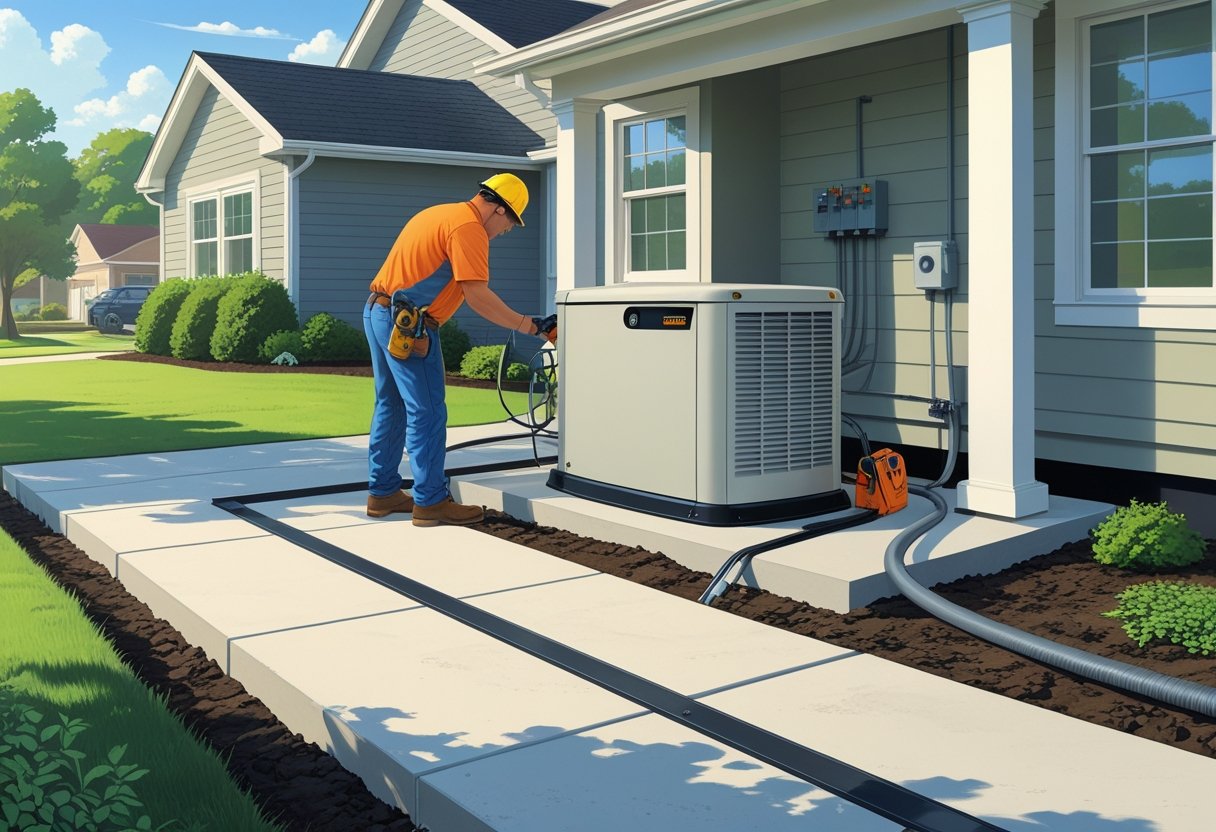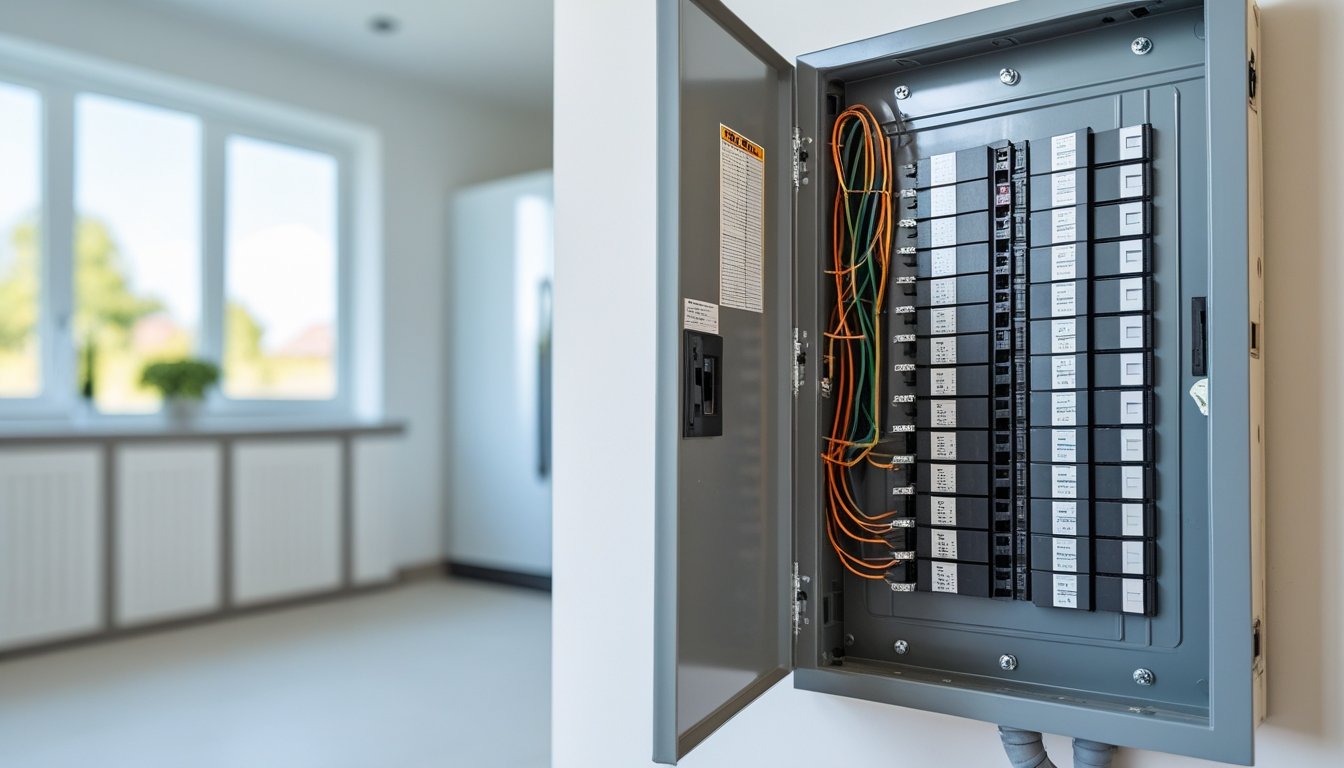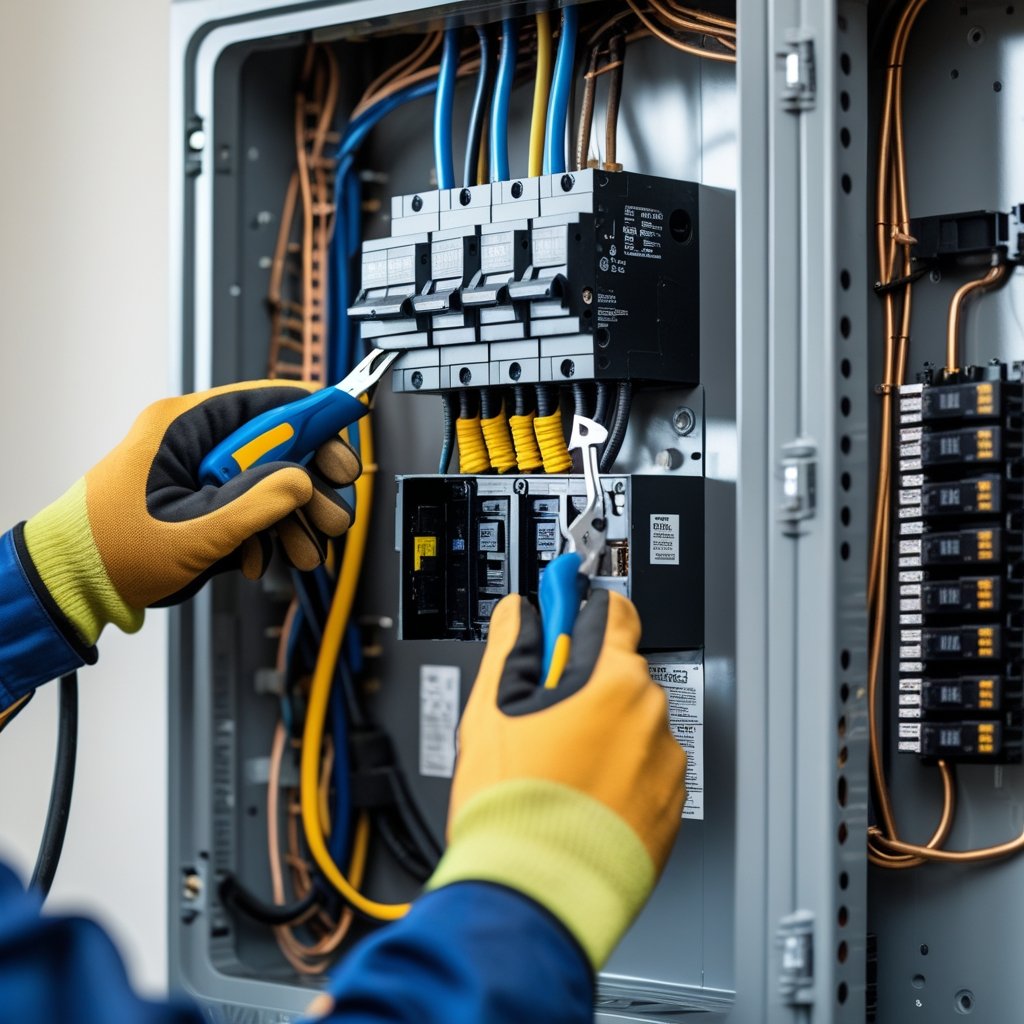Preparing your home for generator installation involves several important steps to ensure safety, efficiency, and long-term reliability. The key to a smooth installation is having a licensed professional assess your electrical system and site conditions before starting the process. This helps avoid costly issues and ensures your backup power works seamlessly when you need it most.
You’ll need to clear and level the installation area, confirm your electrical panel can handle the generator’s load, and coordinate any necessary permits or inspections. At AAA Electrical Services, we emphasize safety-first electrical work done by licensed professionals who treat your home like their own, offering flat-rate pricing and same-day service to make the process hassle-free.
By preparing your home properly, you protect your family and investment while securing peace of mind during outages. Whether you live in Sacramento, Roseville, or nearby areas, getting expert guidance tailored to your home’s unique needs is the best way to move forward confidently.
Assessing Home Power Needs
Before installing a generator, you must understand your home’s power demands precisely. This includes identifying key appliances, calculating their energy use, and deciding if the generator should back up your entire home or just critical systems.
Evaluating Critical Appliances and Systems
Start by listing the appliances and systems essential for your household during an outage. Common priorities include refrigerators, sump pumps, heating or cooling systems, and medical devices. Don’t overlook lighting in key rooms and communication devices.
Focus on appliances that maintain safety and comfort. Non-essential devices like entertainment systems can usually be excluded to save on generator size and cost. If you use well pumps, security systems, or garage door openers, include those in your list too.
Having a clear inventory of critical loads helps you avoid oversizing or undersizing your generator. This tailored approach aligns with modern safety-first electrical work and reduces unnecessary expenses.
Calculating Total Wattage Requirements
Once you know your critical appliances, gather their wattage ratings. These are usually listed on labels or in user manuals. Add both running and starting watts, as some devices, like compressors and pumps, require more energy at startup.
Use a simple table or spreadsheet to total the wattage. For example:
ApplianceRunning WattsStarting WattsRefrigerator7002200Sump Pump10002500Furnace Blower6001200Lighting300300
Next, sum all starting watts to determine the peak load your generator must handle. This ensures reliable power without overloading the system.
If this step seems complex, the professionals at AAA Electrical Services can help. Their licensed technicians provide accurate load assessments with transparent, flat-rate pricing.
Determining Backup vs. Whole-Home Coverage
Decide whether you need a generator that powers only critical appliances or one that supports your entire home. Backup generators focus on safety and comfort essentials, typically requiring smaller units.
Whole-home generators run all your systems simultaneously. They offer seamless power but involve higher initial costs and larger equipment.
Consider your budget, power needs, and how frequently outages occur in Sacramento and surrounding areas. For many homeowners, prioritizing critical loads provides peace of mind while staying cost-effective.
Your decision impacts installation complexity and cost. Getting advice from trusted local experts ensures the system matches your family's safety needs without unnecessary expense.
Site Selection and Generator Placement
Choosing the right spot for your generator is essential for safety, efficiency, and compliance with local rules. You need to think about code requirements, where the generator will safely fit, and proper airflow to prevent hazards.
Checking Local Building Codes and Permits
Before installation, verify local building codes and get the necessary permits. Codes often regulate noise limits, setbacks from property lines, and proper distances from structures. Some areas in Sacramento and surrounding cities require permits issued by the city or county building department.
Ignoring these rules can lead to fines or forced relocation. Your licensed electrician from AAA Electrical Services can help navigate this process to ensure everything is up to code. Having permits approved ahead of time keeps your installation timely and hassle-free.
Selecting a Safe Installation Location
Place your generator on a firm, level surface—typically a concrete pad—to reduce vibration and wear. Avoid areas prone to flooding or standing water. The site should be away from windows, doors, and air intakes to prevent exhaust gases from entering your home.
Distance from living spaces is key; most codes suggest at least 5 feet away from any structure. Take into account access for maintenance and refueling if applicable. Safety and convenience go hand in hand when selecting your generator’s location.
Ensuring Adequate Ventilation and Clearance
Proper ventilation is critical to prevent carbon monoxide buildup and allow the generator to operate efficiently. Maintain enough clearance around the unit—typically 2 to 3 feet on all sides. Never install it in an enclosed space without dedicated ventilation designed for exhaust.
Wind direction should also be considered so fumes are blown away from doors or air intakes. Maintaining these clearances supports safe operation and protects your family. A knowledgeable technician from AAA Electrical Services will ensure your setup meets safety guidelines while fitting your property’s specific layout.
Preparing Electrical and Fuel Systems
Before installing a generator, you must ensure your home’s electrical system can handle the added power load and that fuel delivery is securely arranged. This involves checking your electrical panel’s capacity, planning where fuel lines will run, and deciding on the location and wiring for the transfer switch. Proper preparation reduces delays and safety risks.
Upgrading Electrical Panels if Needed
Your existing electrical panel may not support the extra load of a whole-house generator. Panels that are older or near capacity often need an upgrade to accommodate new circuits and the generator's power flow.
Look for signs like frequent breaker trips or a panel older than 20 years. Upgrading involves installing a higher-capacity panel or adding a subpanel dedicated to generator circuits. This work should always be done by licensed professionals to ensure compliance with electrical codes and safety standards.
AAA Electrical Services provides safety-first electrical work done by licensed professionals, ensuring your panel upgrade supports your home’s power needs without compromising safety.
Arranging Fuel Supply Lines
Fuel choice impacts installation complexity. Common options include natural gas, propane, or diesel. Most whole-house generators connect to your home’s natural gas line or a propane tank.
You must plan fuel lines so they comply with local codes and run safely from your fuel source to the generator. Lines should be installed away from living spaces and protected from damage.
Check that fuel pressure meets the generator manufacturer’s requirements. Fuel supply must be reliable to avoid interrupted power. Scheduling this early allows time for necessary permits and inspections.
Planning for Transfer Switch Installation
A transfer switch controls the power source changeover from utility to generator during an outage. There are manual transfer switches and automatic ones that sense outages and start the generator instantly.
Transfer switches must be sized based on your home’s load and the generator capacity. Improper installation can cause serious electrical hazards or damage to appliances.
Plan its location near your main electrical panel for ease of wiring and service access. A licensed technician will handle the wiring to ensure seamless and safe power transition.
AAA Electrical Services can install transfer switches with honest pricing and no surprises, providing peace of mind when power fails.
Home Readiness and Safety Preparation
Preparing your home for generator installation involves specific steps to ensure safety and smooth access during and after the process. You need to create a clean, accessible, and weather-resistant area around the installation site.
Clearing the Installation Area
Start by removing any debris, vegetation, or obstacles from the generator’s designated spot. A clear area at least 3 feet around the unit is essential to allow proper airflow and maintenance access. Make sure to check that the ground is level and stable to prevent shifting or tilting over time.
Avoid placing the generator near flammable materials or structures that could block exhaust. Keeping this space clear not only complies with safety codes but also helps your generator run efficiently and safely for years.
Ensuring Accessibility for Technicians
Your technicians must have easy access to the installation site and your electrical panel. Clear pathways free of clutter or locked gates ensure they can work quickly and safely, saving you time and potential cost.
Provide safe, well-lit routes, especially if work takes place in the early morning or late afternoon. At AAA Electrical Services, our certified technicians prioritize clear communication and respect your property, arriving prepared with stocked vans for same-day service.
Addressing Weatherproofing Concerns
Your generator will be exposed to outdoor conditions, so protecting it from rain, snow, and heat is critical. Confirm the installation area has proper drainage to prevent water pooling around the unit.
Consider installing a weatherproof enclosure or placing the generator under a covered structure. However, any shelter must not obstruct airflow or exhaust. Sealing around electrical connections with weather-resistant materials prevents corrosion and extends the generator's lifespan, enhancing safety during power outages.
For professional guidance tailored to your Sacramento-area home, rely on specialized services that focus on family safety and clear, upfront pricing.
Coordinating With Professionals
Preparing your home for generator installation involves working closely with qualified experts to ensure safety and compliance. You’ll need to select the right licensed installer and manage necessary inspections and approvals to keep the project on track.
Choosing Licensed Installers
Select a licensed and insured electrician who specializes in generator installation. This ensures the work meets local electrical codes and reduces risks such as electrical hazards or damage to your home.
Look for technicians with certifications and verified experience. AAA Electrical Services offers fully certified professionals who prioritize family safety and provide transparent, flat-rate pricing. Their stocked vans enable same-day service and quick resolutions, minimizing downtime during power outages.
Make sure the installer assesses your power needs accurately to recommend the proper generator size and type. Clear communication about timelines, costs, and responsibilities will prevent surprises and promote a smooth installation.
Scheduling Inspections and Approvals
After hiring your installer, schedule all required local inspections and obtain permits before starting work. Inspection steps usually include reviewing electrical connections, fuel line installations, and overall compliance with safety standards.
Coordinate with your installer to submit documentation to city or county authorities as early as possible. Delays in permits or approvals can extend your installation timeline by weeks.
Your installer should be familiar with your area's rules, particularly in Sacramento and surrounding regions, enabling them to handle inspection scheduling for you. AAA Electrical Services can guide you through this process while emphasizing safety and trustworthiness.
Frequently Asked Questions
Proper preparation ensures your generator installation is safe, efficient, and compliant with local regulations. You will need to address site setup, electrical connections, and legal requirements carefully to avoid issues down the line.
What are the necessary steps to prepare for a home generator installation?
You should start by selecting the correct size and fuel type for your generator based on your home's power needs. Level the installation area and prepare a stable surface like a gravel or concrete pad.
Clear access for the generator and wiring is important. Also, check for any obstacles that might interfere with installation or maintenance.
Which local codes and distance requirements should be considered when placing a generator?
Local building and electrical codes often specify minimum distances from your home, property lines, and combustible structures. Typical regulations require at least 5 to 10 feet clearance.
You must also ensure compliance with noise ordinances and ventilation standards to prevent exhaust buildup or disturbance to neighbors.
What are the electrical wiring considerations for a whole-house generator?
Your generator wiring needs to connect safely to your home’s main electrical panel. This usually involves installing an automatic transfer switch to prevent back-feeding, which can endanger utility workers.
Use proper gauge wiring and follow the manufacturer’s guidelines along with the National Electrical Code (NEC) to ensure safe and effective power transfer.
How can a generator be safely connected to a house without a transfer switch?
Connecting without a transfer switch is not recommended due to safety risks like back-feeding and potential damage to electrical systems. If a makeshift connection is used, it must include a reliable means to isolate the generator from the grid.
For your family’s safety and code compliance, having the correct transfer switch installed by licensed professionals is essential.
What is the process to install a transfer switch for a home generator system?
The transfer switch installation involves shutting off power, mounting the switch near the main panel, and wiring it between the generator and your home circuits. It controls power flow during outages automatically.
AAA Electrical Services offers expert installation with flat-rate pricing, ensuring accurate setup that complies with all safety standards across Sacramento and nearby areas.
Are there specific generator placement guidelines I need to follow?
Generators must be positioned on a firm, level surface away from windows, doors, and vents to prevent carbon monoxide entry. Avoid placing them near flammable materials.
Placement should also ease maintenance access and comply with any local noise or zoning restrictions. Proper siting improves safety and prolongs the generator’s lifespan.





